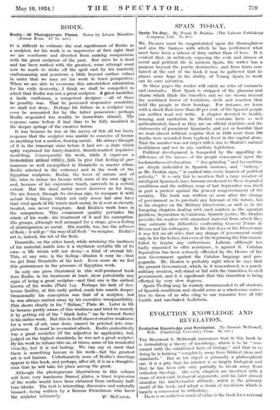RODIN.
Rodin : 60 Photogravure Plates. Notes by Loonie Bénedite. (Ernest Bann. £7 7s. net.) IT is difficult to estimate the real significance of Rodin as a sculptor, for his work is so impressive at first sight that we are overborne and diverted from rnsking comparisons with the great sculpture of the past. But since he is dead and has been ranked with the greatest, some attempt must now be made to shake off the spell cast by his masterly craftsmanship and penetrate a little beyond surface values in order that we may see his work in truer perspective. When we are able to overcome this awestricken admiration for his virile dexterity, I think we shall be compelled to admit that Rodin was not a great sculptor. A great modeller, a facile craftsman, a competent designer — all of these he possibly was. That he possessed responsive sensibility we shall not deny. Perhaps his failure as a sculptor may even be accounted for by the latter possession—perhaps Rodin responded too readily to immediate stimuli. The response came before it had time to be fully moulded in the deeper springs of the creative forces.
It was because he was at the mercy of this all too hasty response that the sculptor was unable to conceive of bronze as anything but a molten, flowing metal. He always thought of- it in the transient state before it had set—a state which aptly expressed his hasty-handed, thumb-marked impulsive modelling. Consequently his work, while it expresses a
tremendous animal virility, fails to give that feeling of per-
manence so well exemplified in Donatello (a master whom Rodin admired in the extreme) and in the work of the Egyptian sculptors. Rodin, the lover of nature and of life, tries to imbue his bronze with some of his own v ig and, because of his expressive touch, succeeds to a certain extent. But the dead metal never deceives us for long. We are forced, through its obvious aim, to compare it with actual living things which not only move but also have that vital spark of life which inert metal, be it ever so cleverly treated, can never recapture. And Rodin's work loses in the comparison. This evanescent quality pervades the whole of his work—his treatment of it and his conception. His groups, although well arranged for a stage, give a feeling of disintegration as metal. His marble, too, has the softness of flesh ; it will go " the way of all flesh " we imagine. Rodin's art is, indeed, the art of the flesh.
Donatello, on the other hand, while retaining the inertness of his material, instils into it a rhythmic metallic life of its own—a life which will not decay—a kind of eternal life. This, at any rate, is the feeling—illusion it may be—that we get from Donatello at his best. Even more do we feel this permanence in the presence of Egyptian work.
In only one piece illustrated in this well-produced book does Rodin, in his treatment at least, show potentially any signs of being a great sculptor—and that one is the earliest known of his works (Plate 1A). Perhaps his lack of dex- terous facility, at this early period, made him search deeper. Occasionally his conception was that of a sculptor, but he was always carried away by his executive irresponsibility. This shows clearly in his " Balzac," Plate 48. Later in life he became partly aware of this weakness and tried to remedy it by getting rid of the " black holes " (as he termed them) in his earlier work. But this in itself showed creative weakness, for a work of art, once done, cannot be patched into com- pleteness. It must be re-created afresh. Rodin undoubtedly was a great modeller (if the adjective be applicable), but, judged on the highest standards, he was not a great sculptor. By his work he infuses into us, at times, some of his wonderful vivacity, but it is not lasting. We can say at most that there is something human in his work—but the greatest art is not human. Unfortunately none of Rodin's drawings appear in this book, and perhaps, after all, it is as a draughts- man that he will take his place among the great.
Although the photogravure illustrations in this volume will form very handsome framed plates, a truer impression of the works would have been obtained from ordinary half- tone blocks. The text is interesting, discursive and naturally biassed—being written by a famous Frenchman who knew






































 Previous page
Previous page